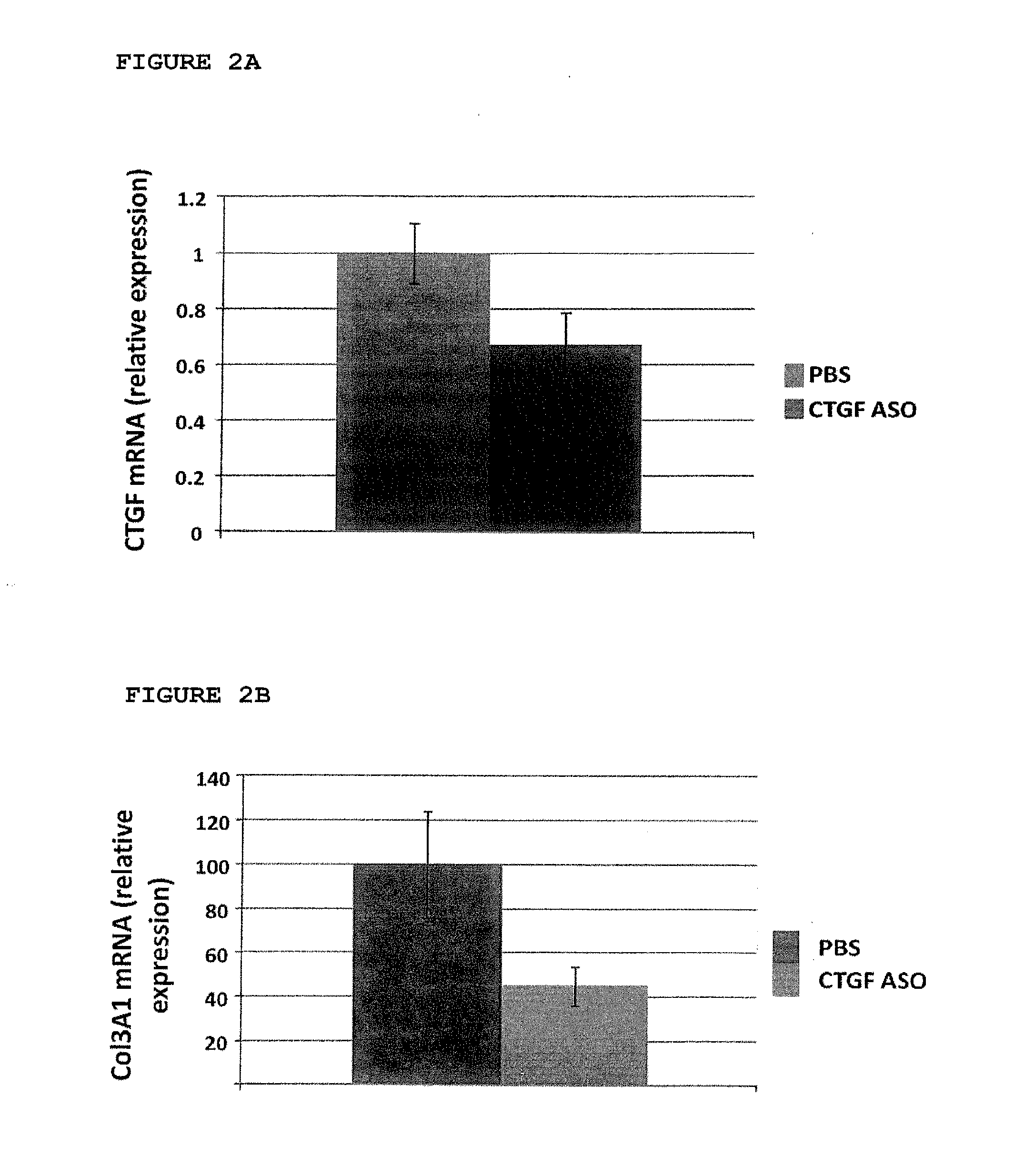Method of treating keloids or hypertrophic scars using antisense compounds targeting connective tissue growth factor (CTGF)
a technology of connective tissue growth factor and antisense compounds, which is applied in the direction of drug compositions, peptide/protein ingredients, therapy, etc., can solve the problems of limited efficacy, no effective single therapeutic regimen has been established for the treatment of keloids, and limiting joint mobility, so as to prevent reduce the formation, reformation or growth of scars, and prevent the formation of scars.
- Summary
- Abstract
- Description
- Claims
- Application Information
AI Technical Summary
Benefits of technology
Problems solved by technology
Method used
Image
Examples
example 1
Selection of Lead Human Connective Tissue Growth Factors (CTGF) Antisense Oligonucleotides Candidate
Introduction
[0255]A series of oligonucleotides were designed to target different regions of the human connective tissue growth factor RNA, using published sequences (GenBank accession number NM—001901.2, incorporated herein as SEQ ID NO: 9, and GenBank accession number NT—025741.14, incorporated herein as SEQ ID NO: 10).
[0256]This study analyzes available sequence space and modified antisense oligonucleotides targeting both exonic and intronic space of CTGF. Approximately 150 novel sequences per target were synthesized and evaluated for activity against CTGF in cell-culture. The oligonucleotides are shown in Table 1. All compounds in Table 1 are chimeric oligonucleotides (“gapmers”) 20 nucleotides in length, composed of a central “gap” region consisting of either ten 2′-deoxynucleotides, which is flanked on both sides (5′ and 3′ directions) by five-nucleotides “wings” or 13 2′-deoxynu...
example 2
A Single-Dose Intra-Dermal Pharmacokinetic Study of CTGF Antisense Oligonucleotide in Rabbits
Study Objective
[0266]The purpose of this pharmacokinetic study in rabbit is to evaluate the diffusion and concentration of a CTGF antisense oligonucleotide (SEQ ID NO:39, ISIS 412294) in rabbit skin at different times subsequent to a single intra-dermal injection.
Study Design
[0267]On day 0 of the study all animals were dosed intra-dermally (ID) with a single 100 μL injection of CTGF antisense oligonucleotide SEQ ID NO:39 at a concentration of 50 mg / mL (5 mg total dose). The animals were dosed with the antisense oligonucleotide in a site to the left of the spinal mid-line, roughly parallel to the rabbit's shoulders and adjacent to a suture 3 cm incisional wound (FIG. 1A). The needle was inserted so that the test material was injected down towards the base of the animal's body. On days 1, 3, 7 or 14, the rabbits were euthanized and two full-thickness 1.0 cm punch biopsies were obtained, one ce...
example 3
Animal Study with CTGF Antisense Oligonucleotide Targeting Human Keloids in an In Vivo Model System
Study Objective
[0269]The purpose of this study was to evaluate the efficacy of antisense oligonucleotides targeting human CTGF in an in vivo model system using a human keloid / mouse xenograft model. The oligonucleotide tested was antisense oligonucleotide No. 412300 (SEQ ID NO: 45).
Methods
Human Keloid / Mouse Xenograft Model.
[0270]A human keloid / mouse xenograft model using transplanted human keloid tissue into nude mice was used.
[0271]Fresh specimens of keloid tissue were obtained anonymously, from discarded tissue of patients undergoing elective excision of keloids for cosmetic reasons. The keloid samples were processed into 10×5×5 mm samples and weighed on an analytical balance. The keloid samples were then implanted into the mice as described below.
[0272]Mice were anaesthetized using 3% isoflurane. Buprenorphine was given before surgery and post-operatively, as needed (Buprenorphine at...
PUM
| Property | Measurement | Unit |
|---|---|---|
| residence time | aaaaa | aaaaa |
| distance | aaaaa | aaaaa |
| distance | aaaaa | aaaaa |
Abstract
Description
Claims
Application Information
 Login to View More
Login to View More - R&D
- Intellectual Property
- Life Sciences
- Materials
- Tech Scout
- Unparalleled Data Quality
- Higher Quality Content
- 60% Fewer Hallucinations
Browse by: Latest US Patents, China's latest patents, Technical Efficacy Thesaurus, Application Domain, Technology Topic, Popular Technical Reports.
© 2025 PatSnap. All rights reserved.Legal|Privacy policy|Modern Slavery Act Transparency Statement|Sitemap|About US| Contact US: help@patsnap.com



